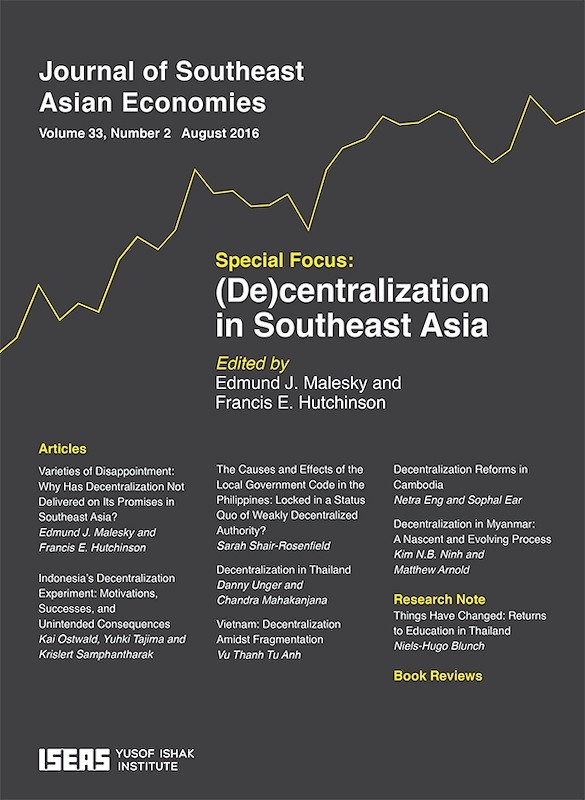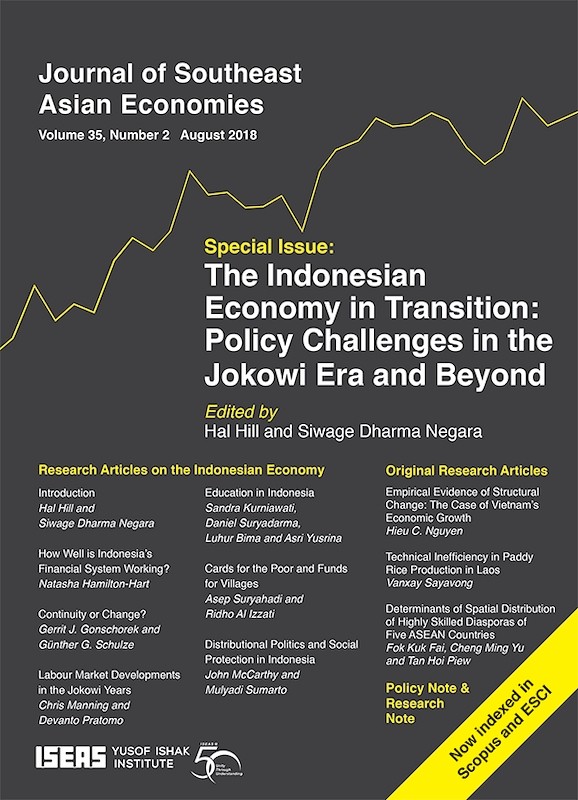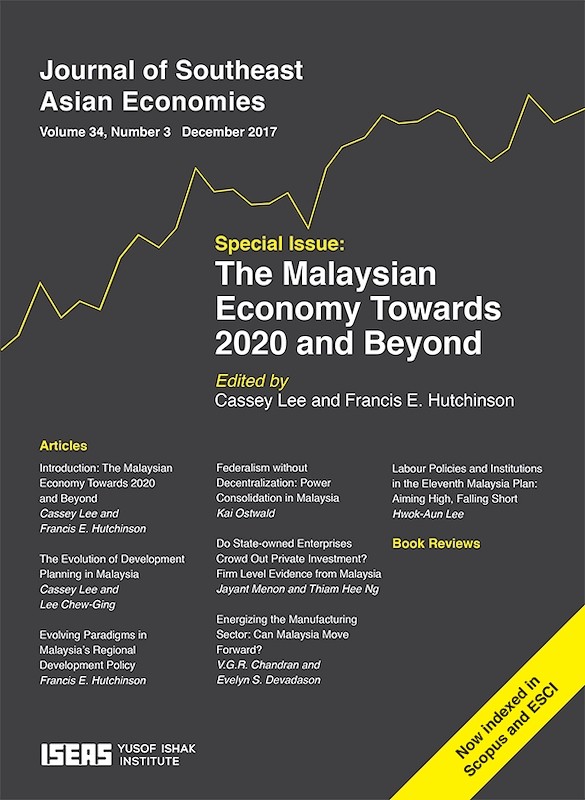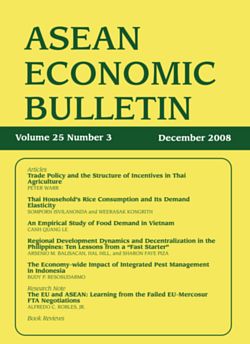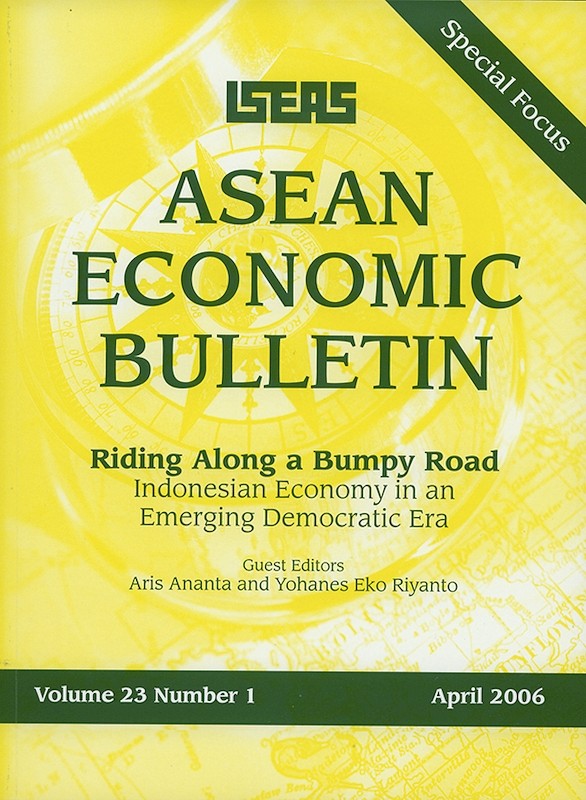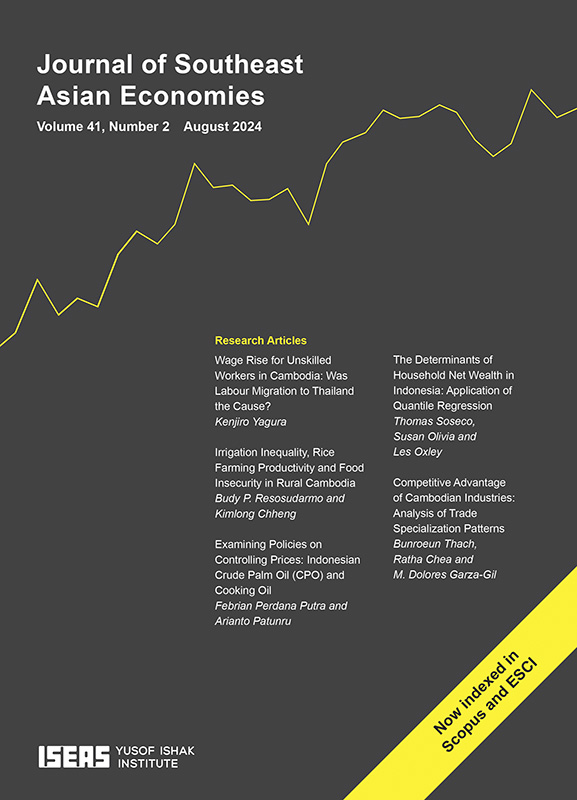Journal of Southeast Asian Economies Vol. 38/3 (December 2021). Special focus on "Impact of Indonesia’s Decentralization Reforms Twenty Years On"
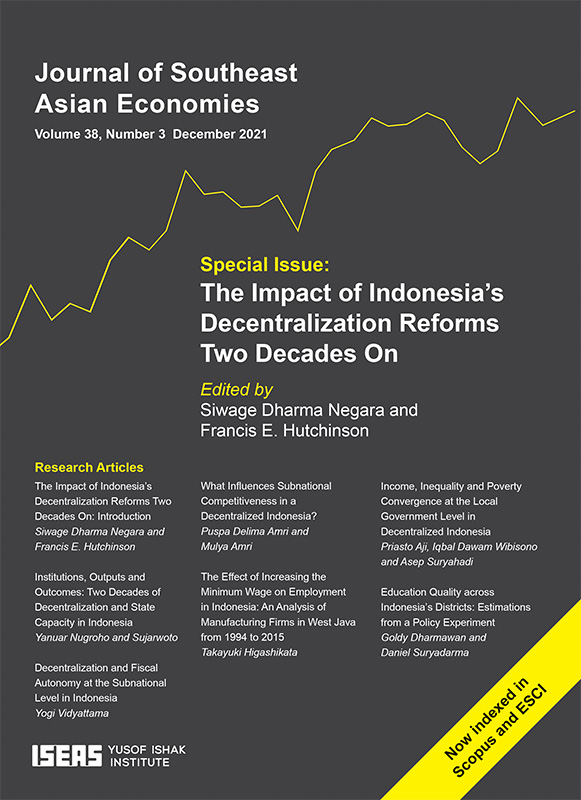
Date of publication:
December 2021
Publisher:
ISEAS – Yusof Ishak Institute
Number of pages:
138
Code:
AE38/3
Contents
-
Journal of Southeast Asian Economies Vol. 38/3 (December 2021). Special focus on "Impact of Indonesia’s Decentralization Reforms Twenty Years On"
[Whole Publication, ISSN: 23395206] -
Preliminary pages
- ARTICLES
-
1. The Impact of Indonesia’s Decentralization Reforms Two Decades On: Introduction, by Siwage Dharma Negara, Francis E Hutchinson, authors
-
2. Institutions, Outputs and Outcomes: Two Decades of Decentralization and State Capacity in Indonesia, by Yanuar Nugroho, Sujarwoto, authors see abstractSince the 1998 Reformasi process, Indonesia has decentralized and granted wide-ranging autonomy to its subnational governments. Two decades following these reforms, it is crucial to ask the extent to which decentralization has strengthened state capacity—namely, the ability of the administration to deliver development. Of the various dimensions of state capacity, we focus on two: the structure of public administration; and the provision of local public services. To this end, we analyse statistics from the periods prior to and following decentralization. In addition, we draw on key informant interviews and refer to our personal experience in government to provide depth and nuance to our findings. We find that, in some respects, decentralization in Indonesia has managed to achieve what it promised, but failed to deliver in others. Most indicators of state capacity regarding the delivery of public services improved under decentralization. This progress was probably linked to the increase in the quality of public administration at the local level. However, disparities and gaps in local state capacity are also evident. In some aspects of the economy, the disparity in the provision of social and basic services has deepened. Decentralization has also made policy coordination between central and subnational governments in delivering development more complex, due to the high level of political intervention at both levels.
-
3. Decentralization and Fiscal Autonomy at the Subnational Level in Indonesia, by Yogi Vidyattama, author see abstractThis article revisits the issue of fiscal autonomy at the subnational level following the implementation of Indonesia’s 2001 decentralization reforms. Its main research question is whether the reforms allow a bigger space for local governments to generate their own revenue and fund their initiatives. To this end, the article analyses the size and proportion of intergovernmental transfers from the centre to local and provincial governments since the start of decentralization. It then assesses the funds that subnational governments have to finance their own programmes and initiatives, as well as the proportion of revenue that these governments raise themselves. The study argues that, despite changes in legislation, responsibility for expenditure has been consistently handed to local and, to a lesser extent, provincial governments. However, this has not translated into greater autonomy for them to establish and finance their own initiatives. Conversely, local governments have been pushing for more control over their revenue by introducing various taxes and user charges. This has resulted in a slight increase in the proportion of revenue raised at the local level.
-
4. What Influences Subnational Competitiveness in a Decentralized Indonesia?, by Puspa Delima Amri, Mulya Amri, authors see abstractOne of the objectives of Indonesia’s 2001 decentralization reform was to enable the country’s subnational regions (provinces, cities and regencies) to realize their unique potential and, thus, implicitly, maximize their competitive advantage. While we have seen some improvements in socio-economic development and democratic accountability, stark variations in economic outcomes across regions remain. Why are some more successful than others in achieving competitiveness? Focusing primarily on district-level data from 1998 to 2016, this paper systematically examines the factors that may influence variations in subnational competitiveness in Indonesia. We found significant correlations between competitiveness and fiscal decentralization measures and, separately, between competitiveness at the province level and elements of democracy.
-
5. The Effect of Increasing the Minimum Wage on Employment in Indonesia: An Analysis of Manufacturing Firms in West Java from 1994 to 2015, by Takayuki Higashikata, author see abstractAfter Indonesia introduced its sweeping decentralization reforms in 2001, basic government functions—including the authority to set minimum wages—were devolved to local governments. We study the effect of increases in the minimum wage on employment by examining plant-level panel data from 1994 to 2015. We focus on five neighbouring local government areas in West Java province, which used to have the same minimum wage before the 2001 reforms and which have since established different minimum levels of mandatory remuneration. According to our baseline analysis, a 1 per cent increase in the minimum wage in real terms reduced the number of workers employed by manufacturing plants in that area the following year by 0.35 to 0.51 per cent. This suggests that, after 2001, the number of employees in manufacturing firms operating in the local government with the highest average minimum wage (Bekasi municipality) decreased by 3.7 to 5.4 per cent compared to the municipality with the lowest average minimum wage (Bogor municipality). We also find that the negative effects were mainly observed in large plants with more than 100 employees as of 1994. We check the robustness of our baseline analysis by changing the definition of factory size, including plants that had exited the labour market or moved out to other locations, and by changing the specification of time trends by local government.
-
6. Income, Inequality and Poverty Convergence at the Local Government Level in Decentralized Indonesia, by Priasto Aji, Iqbal Dawam Wibisono, Asep Suryahadi, authors see abstractSince the launch of Indonesia's decentralization reforms in 2001, the country has achieved significant progress in improving the welfare of its citizens—as seen from increasing income per capita and decreasing poverty levels. However, vertical inequality has increased, raising concerns whether inequality between different parts of the country has also grown. Using spatial econometric models with data covering the 2002–19 period, this paper examines whether there has been a convergence or divergence in income per capita, inequality and poverty across local government areas in Indonesia. The findings indicate that there has been a conditional convergence of these development outcomes across local government areas. This means that the levels of income per capita, inequality and poverty across the country's municipalities and regencies will converge, but the gaps will not be completely eliminated due to differences in their endowment factors. This conditional convergence occurs across municipalities and across regencies as well as across local government areas in Java and outside Java, but at different rates of convergence. This finding implies that Indonesia needs to maintain its decentralization policy and resist efforts to recentralize revenue sources and responsibilities. In addition, this should be complemented by efforts to assist areas with low income per capita, high inequality and high poverty rates to improve their endowment factors and institutions.
-
7. Education Quality across Indonesia's Districts: Estimations from a Policy Experiment, by Goldy Dharmawan, Daniel Suryadarma, authors see abstractAn education system needs valid and objective information on student learning outcomes at a sufficiently disaggregated geographical level. Such data can inform policymakers on specific aspects in each geographical area that require attention and provide an indication of the returns to public investments in education. They are the starting point for any effort to improve the performance of an education system. Without information on learning outcomes, policy reforms or higher public investments in education are unlikely to be effective. Indonesia's education system does not currently have such information. In this paper, we take advantage of a government policy to change the mode of the national examination administration, from paper-based to computer-based testing, to estimate the quality of education in Indonesia at the district level. Our results indicate that education quality across the country's districts is highly heterogeneous. The gap in results between the highest-scoring and lowest-scoring districts shows that children in the latter have been attending schools for nine years with minimal learning outcomes. We find that, over the course of one year, the average quality of education has increased slightly and the variation in quality has declined slightly. However, these national averages mask significant heterogeneities across and within districts.

